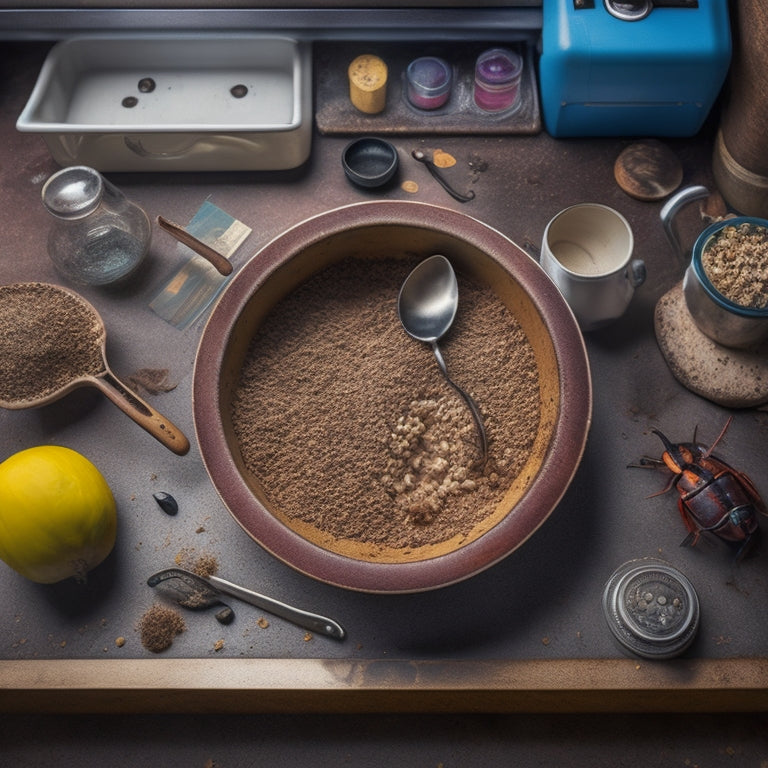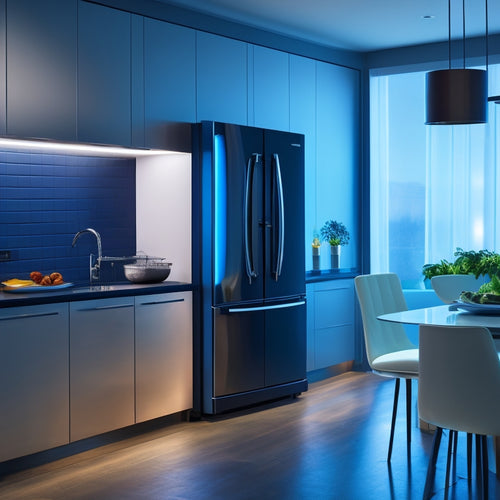
What's Hiding in Your Kitchen Drawers?
Share
You likely have a collection of unused kitchen gadgets, duplicate utensils, and mismatched containers taking up valuable space in your kitchen drawers, making it difficult to find what you need when you need it. It's time to sort through the chaos, purge what you don't need, and assign a home for each item. By maximizing your drawer storage space and categorizing your gadgets, you'll regain control over your kitchen. You'll discover hidden areas waiting to be optimized, and streamline your workflow efficiency. Now, take the next step to uncover the secrets to a more organized, functional kitchen.
Key Takeaways
• Cluttered kitchen drawers often hide unused or duplicated utensils, taking up valuable space and causing frustration.
• Assigning a designated spot for each item and labeling compartments can help maintain organization and simplify meal prep.
• Maximizing vertical storage options and using dividers can optimize drawer space and reduce clutter.
• Implementing a categorization system for kitchen gadgets and tools can help identify and purge unnecessary items.
• Regular cleaning and maintenance can prevent clutter from resurfacing and ensure a functional and efficient kitchen.
Decluttering Kitchen Utensil Chaos
Decluttering Kitchen Utensil Chaos
Start by gathering all your kitchen utensils from every nook and cranny, and sort them into categories like baking, cooking, and serving tools. This initial step will give you a clear picture of what you have and what you can get rid of. Be ruthless – if you haven't used it in the past year, it's probably safe to let it go. This utensil purge will help you declutter your kitchen and make room for the tools that truly matter.
Next, focus on organizing tools that you use regularly. Designate a specific spot for each item, and make sure it's easily accessible. This will save you time and frustration in the long run. Consider investing in a utensil organizer or divider to keep your kitchen drawers tidy.
Maximizing Drawer Storage Space
With your utensils sorted and purged, it's time to optimize the storage space in your kitchen drawers to keep them organized and within easy reach.
You're now ready to create a system that works for you, not against you.
To maximize drawer storage space, start by using drawer dividers to separate utensils into categories. This will prevent clutter from building up again and make it easier to find what you need.
Next, consider vertical storage options, such as stackable trays or baskets, to make the most of your drawer's vertical space. This will allow you to store more items in a smaller area, keeping your countertops clear.
Categorizing Kitchen Gadget Clutter
You'll likely find that your kitchen drawers are overflowing with gadgets, so start by grouping similar items, like cooking utensils, baking tools, and dinnerware, into categories to tame the clutter. This is the first step in creating organizing solutions that will help you regain control over your kitchen space.
By categorizing your gadgets, you'll be able to see what you have, what you need, and what you can get rid of.
Next, think about how you can utilize vertical space in your drawers. Installing drawer dividers or shelves can help keep items separated and organized, making the most of the available space.
Consider implementing space-saving hacks like storing small items in baskets or containers, or using adhesive hooks to hang items like utensils or oven mitts. By categorizing and containing your gadgets, you'll be able to create a more efficient and functional kitchen that works for you, not against you.
With a little creativity and planning, you can turn your cluttered kitchen drawers into a model of organization and productivity.
Assigning a Home for Each Item
Now that you've categorized your kitchen gadgets, it's time to assign a home for each item.
You'll want to designate a specific spot for each group of similar items, making it easy to find what you need when you need it.
Designate a Spot
Assign a specific spot in your kitchen drawers for each item, ensuring that everything has a designated home where it can be easily found and put back. This will save you time and frustration when you're cooking or cleaning up.
Start by organizing your silverware, separating utensils like forks, knives, and spoons into their own compartments. Label each compartment so you can quickly identify what's inside.
You can also assign a spot for less frequently used items like special occasion dishes or cooking gadgets. Consider the items you use most often and place them in easy-to-reach locations.
By designating a spot for each item, you'll maintain a sense of order and control in your kitchen. This system will also help you identify what you need to restock or replace.
With everything in its place, you'll be able to focus on cooking and enjoying meals with your family and friends.
Categorize Similar Items
Group similar items, like cooking utensils or baking supplies, together in the same drawer or compartment to create a sense of cohesion and make them easier to find when you need them. This way, you'll avoid rummaging through multiple drawers to find what you're looking for.
Here are some examples of categorized groups:
-
Sorting utensils: whisks, spatulas, and wooden spoons in one drawer
-
Organizing spices: alphabetical order or by frequency of use
-
Grouping tools: can opener, wine opener, and garlic press in a designated tool drawer
-
Arranging cutlery: separating knives, forks, and spoons into separate compartments
-
Storing baking supplies: flour, sugar, and baking powder in a designated baking cabinet
Streamlining Kitchen Workflow Efficiency
As you organize your kitchen drawers, you're not just tidying up - you're setting yourself up for success in the kitchen.
By optimizing storage spaces, you'll reduce the time you spend searching for ingredients and tools, freeing you up to focus on cooking.
Optimize Storage Spaces
You can greatly reduce kitchen clutter and boost efficiency by strategically organizing your storage spaces, starting with the often-overlooked areas like the 'dead' zones behind appliances and corners of cabinets. By maximizing these hidden areas, you'll create a more streamlined kitchen workflow.
Here are some space-saving tips to get you started:
-
Install drawer dividers to separate utensils, cookware, and dinnerware, making it easier to find what you need when you need it.
-
Utilize the back of cabinet doors with adhesive hooks, baskets, or shelves to store spices, oils, or frequently used items.
-
Designate a specific drawer for kitchen gadgets and tools, keeping them organized and out of the way.
-
Consider a lazy Susan in a corner cabinet to access hard-to-reach items with ease.
-
Implement a 'one in, one out' policy to maintain your newly organized space and prevent clutter from building up again.
Simplify Cooking Processes
By streamlining your kitchen workflow, you'll shave precious minutes off meal preparation and cooking times, making it easier to get a healthy, delicious meal on the table. To achieve this, focus on time-saving meal prep techniques, such as chopping ingredients in advance, cooking proteins in bulk, and prepping entire meals on the weekends. These simple hacks will free up time during the week, allowing you to focus on more important things.
Another key strategy is to master easy recipe hacks. For example, learn how to cook a perfect omelette in under 5 minutes, or whip up a week's worth of salad jars in 30 minutes. These quick and easy recipes will become your go-to's for busy nights, and can be customized to suit your dietary needs and preferences.
Maintaining Your Organized Kitchen
Your newly organized kitchen requires regular tuning to prevent clutter from creeping back in. You've worked hard to create a space that's efficient and functional, and it's crucial to maintain that order to sustain its functionality.
To keep your kitchen in top shape, make it a habit to:
-
Label containers and color-code utensils to guarantee everything has its designated spot
-
Utilize drawer dividers to separate items and avoid clutter from accumulating
-
Implement vertical storage to optimize your cabinet space
-
Allocate time each week to wipe down surfaces and clean up crumbs and spills
-
Remove items you no longer need to prevent clutter from resurfacing
Frequently Asked Questions
How Do I Deal With Kitchen Gadgets With No Designated Storage Space?
"Did you know 75% of Americans own at least 10 kitchen gadgets? You deal with them by finding creative solutions, like repurposing containers or using adhesive hooks, and implementing decluttering strategies, such as categorizing and storing items by frequency of use."
Can I Repurpose Old Kitchen Items for New Uses?
You can repurpose old kitchen items for new uses by thinking creatively about alternative uses, like turning an old mason jar into a utensil holder or a vintage colander into a planter, through creative upcycling and recycling.
How Often Should I Clean and Maintain My Kitchen Drawers?
As you open the treasure chest of your kitchen, you'll find hidden riches, but only if you tidy up regularly. You should clean and maintain your kitchen drawers every 3-6 months, using drawer liners and dividers to keep things organized and sparkling.
What if I Have Limited Kitchen Drawer Space to Work With?
When dealing with limited kitchen drawer space, you're maximizing storage by using drawer dividers and vertical storage solutions, and exploring under cabinet organizers and magnetic strips to optimize every inch.
Are There Any Eco-Friendly Kitchen Drawer Organization Options Available?
You're looking for eco-friendly kitchen drawer organization options. Fortunately, you'll find sustainable solutions like bamboo dividers and eco-friendly alternatives made from recycled materials, allowing you to stay organized while reducing your environmental footprint.
Related Posts
-

Why Cluttered Spaces Hold You Back From Productivity
You're struggling to get things done amidst the chaos of your cluttered space. It's not just a physical mess - it's m...
-

7 Essential Tips for a High-Tech Kitchen
You're about to revolutionize your cooking experience with a high-tech kitchen that combines smart appliances, automa...
-

7 Best Corner Shelving Units for Home
You're looking to optimize your home's corner spaces with stylish and functional shelving units. Corner shelves are a...


